Troubleshooting Mercedes-Benz ABC Suspension Problems
Have troubles with your Mercedes-Benz ABS suspension? Learn how to troubleshoot the problem by following the procedures below. This guide covers some of the most common problems affecting Mercedes-Benz vehicles with Active Body Control (ABC) hydraulic suspension. Mercedes-Benz ABC suspension has been around since the early 2000s and can be found on high-end models such as the S-Class, SL-Class, and CL-Class AMG models.
Unfortunately, even 20+ years later, very few mechanics know how to work and diagnose problems with the ABC suspension. Reading this article and learning about what can go wrong with the Mercedes-Benz ABC suspension can save you time, money, and headaches.
ABC uses hydraulic pressure to actively adjust the suspension in real-time. The system consists of hydraulic cylinders attached to the suspension and a hydraulic pump pressuring the fluid running through the system. The ABC system can adjust the suspension individually at each wheel, allowing precise control of the vehicle’s body roll, pitch, and dive.
The ABC system is controlled by an ABC control module, which receives input from various sensors located on the vehicle. These sensors monitor the vehicle’s speed, acceleration, steering angle, and other factors that affect the vehicle’s handling.
If the ABC system detects a fault or malfunction, it will trigger a warning light on the dashboard and store a fault code in the system’s control unit. A professional-grade diagnostic scanner such as YOUCANIC UCAN-II scanner is required to access these codes and diagnose the specific issue with the system.

The ABC suspension system is typically found on high-end Mercedes-Benz models, such as the S-Class, CL-Class, and SL-Class. It is designed to provide superior handling and ride quality, particularly in high-performance driving situations.
What does the ABC visit workshop mean for a Mercedes-Benz?
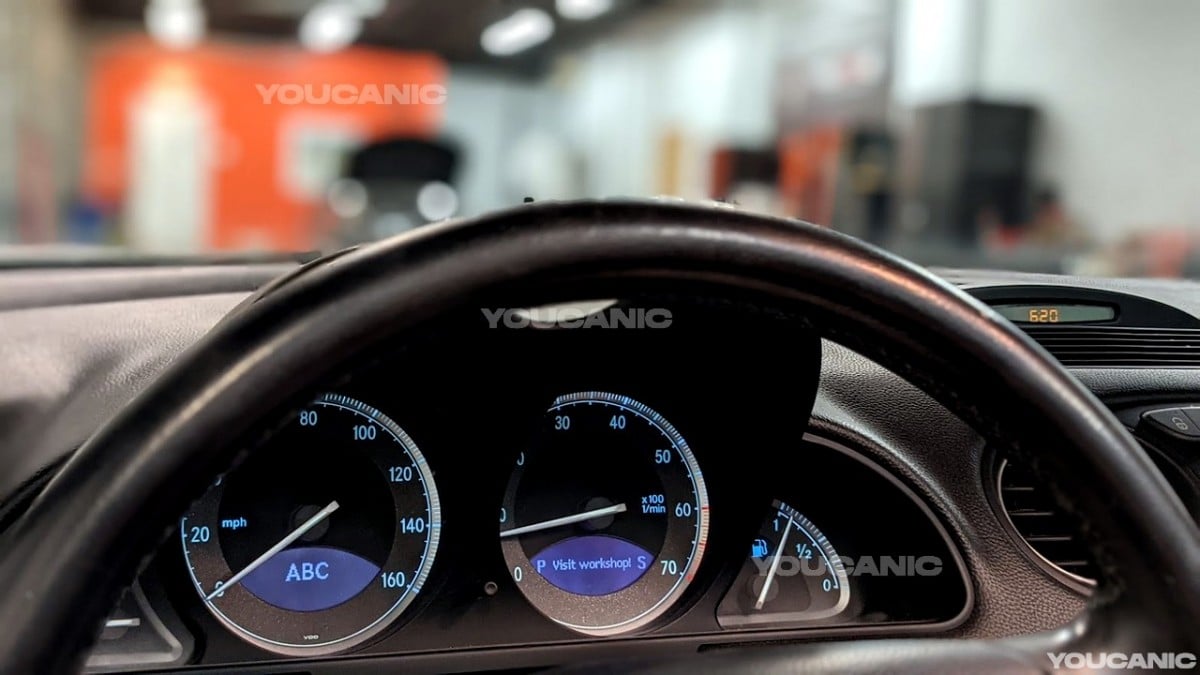
ABC Visit workshop warning message on a Mercedes-Benz means that the Active Body Control (ABC) control module has detected a fault with the hydraulic suspension. If the problem is critical, you will receive a red ABC message, and the vehicle may drop too low or become too bouncy. If the problem is less severe, the warning message will be white, and you should be able to continue driving. The YOUCANIC UCAN-II scanner can read the codes from the ABC control module and clear the codes after you fix the problem.
If you receive the ABC warning on your Mercedes-Benz cluster for the first time, pull over where it is safe and restart the vehicle. Make sure to remove the key for at least one minute. In many cases, a simple engine restart can clear ABC warning messages. If the ABC warning message comes on again:
- Pull over, park safely, and shut off the engine.
- Remove the key from the ignition.
- Open the hood and check the ABC fluid level.
- If the level is low, add ABC fluid. A low level means a leak or an accumulator has failed. Also, inspect the color of the hydraulic fluid. The new ABC fluid is clear and green in color. The old liquid will be dark or brown.
- Drive carefully to an auto repair shop and inspect the ABC system for leaks. Find an auto mechanic who is familiar with the Mercedes-Benz ABC system. Repairing ABC suspension is complex; few mechanics are familiar with this system. It is common for a mechanic to replace ABC components, but the problem persists.
If there are no fluid leaks, the next step is to run a diagnostic check. You can NOT use any OBD-II scanner for this step but will need a Mercedes-Benz diagnostic scanner. Continue reading to learn more about the symptoms and common failures of the ABC suspension.
Symptoms

The most common symptoms indicating failure of the ABC system include a warning on the dashboard and
- A vehicle sits too low at one corner or all around
- The ride is too bouncy
- ABC Warning or STOP message on the dashboard
- STOP Car too low warning message on dashboard
- Raise vehicle suspension button does not work
- System pressure is too low when reading codes with Star Diagnostic
- ABC red light comes on the instrument cluster
- ABC warning comes on when hitting speed bumps
- Red ABC warning flashes on and off
- Hydraulic fluid leaks on the ground
- ABC “visit workshop” warning message
- ABC “drive carefully” warning message
- The vehicle does not raise when the engine is started
- Fault codes present in the Active Body Control module
- Growling sound when the engine is started
- ABC operates okay when cold; error messages appear after the car has warmed up.
Driving with the ABC warning message is not recommended, especially if the warning is RED. If the error message is white, you should carefully drive home or to the nearest auto repair shop.
Troubleshooting by Symptom
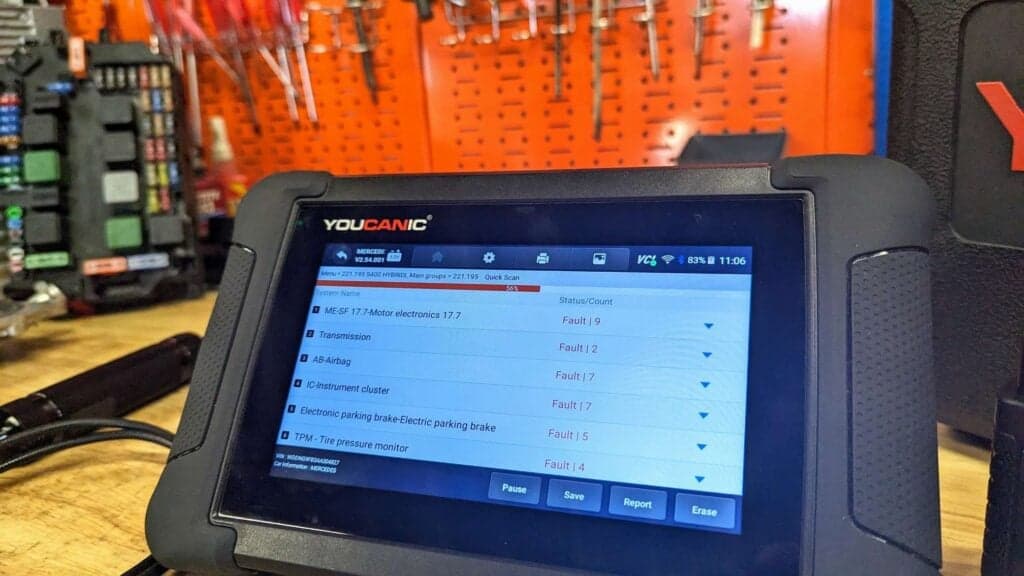
Do not replace parts solely on the symptoms described here. Always read the codes with a Mercedes-Benz Scanner to confirm the problem.
One good example of a multi-system scanner is the YOUCANIC Full Systems Scanner. This scanner can read and clear fault codes from all the systems in your Mercedes-Benz. It can also perform bi-directional tests, maintenance and repair resets, etc.
“ABC Drive Carefully” or “ABC Visit Workshop”
If you notice an ABC warning message related to the ABC suspension on the dashboard, the hydraulic suspension has a problem, and a fault code is stored in the ABC control module. Do not drive with a red ABC warning light on. If you continue to drive, the ABC pump can get damaged, which is a costly repair.
If the color is white or blue, the warning is not as critical, and in most cases, you can continue driving. If the ABC warning is red, it indicates a critical problem. The ABC system may turn off, or the vehicle may lower. A red ABC warning on the dashboard means it is unsafe to continue driving your Mercedes-Benz. If the warning is read, the vehicle height drops to an unacceptable level, and the instrument cluster will display a “Stop, Vehicle Too Low” warning. We recommend having the car towed instead of continuing to drive and ending up with expensive repairs or causing an accident.

The ABC system may lock the sturts at the standard position if there is a critical error. The ride becomes bouncy or rough because there is no longer fluid circulation.
Possible problems:
- A loose connection electrical connection
- A failed ABC sensor
- ABC pump has failed
- ABC system has a leak
- ABC fluid level is low.
The problem is likely due to a pressure drop if the ABC warning message only appears at startup and then turns off. The ABC warning may turn off when pressure builds up and the suspension works properly. The warning message should turn off as well.
If the ABC warning message continues, there is a system problem, and a fault code will be present in the ABC module. You will need to read the codes with a Mercedes-Benz scanner.
Can not Start Rodeo Test
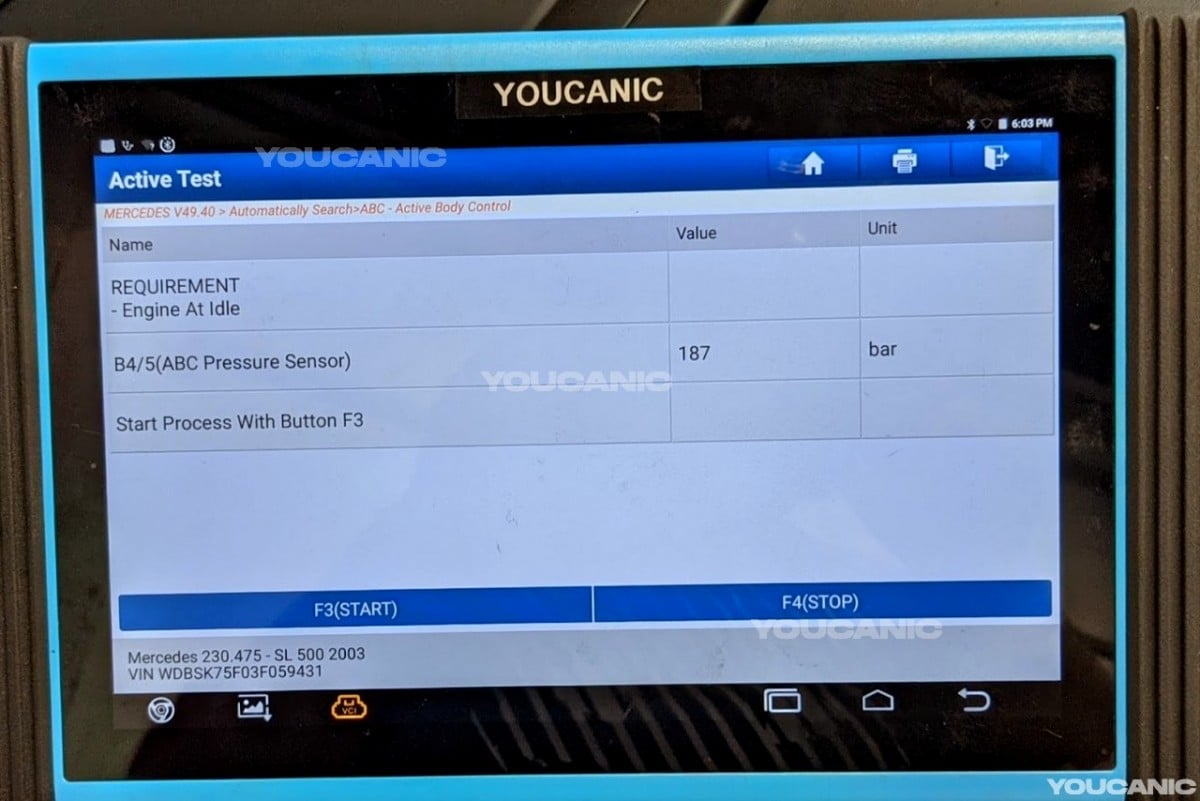
If active fault codes on the ABC module point to low pressure, you may not start the redo test. Read the codes to find out what is wrong. If you have fault code “B4/5 ABC pressure sensor 0 bar” and no action, the ABC pump may be faulty or have no hydraulic fluid due to a large leak in the system.
Can not calibrate ABC suspension
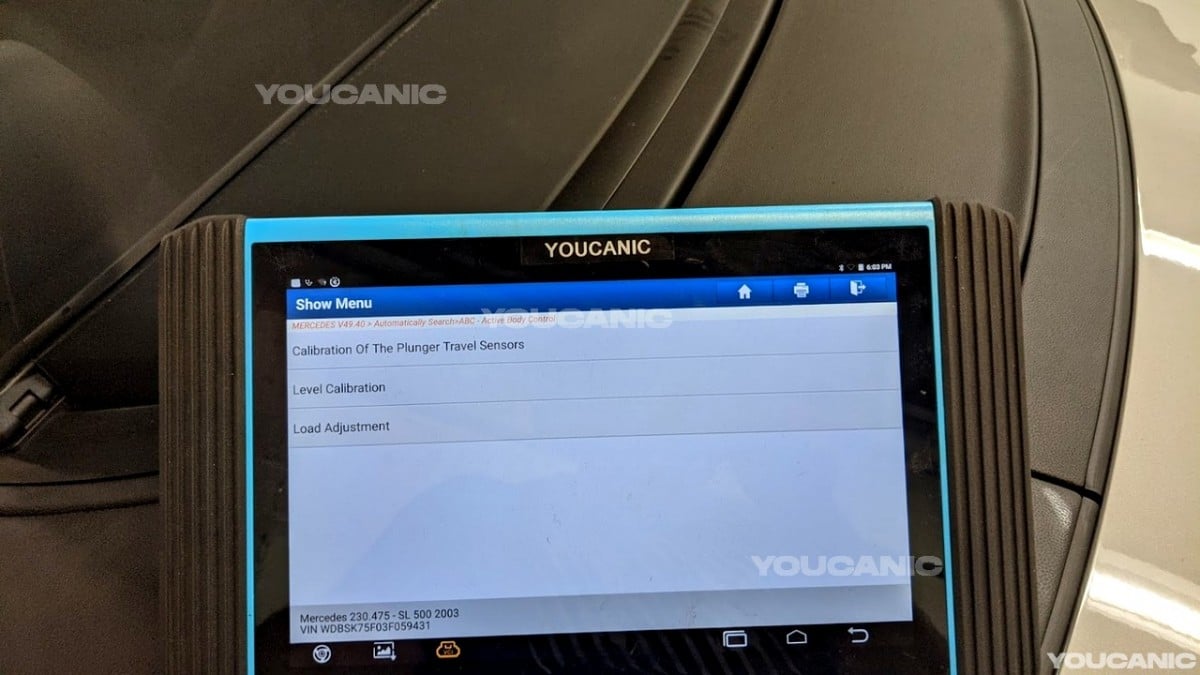
If there are no leaks around the pressure sensor or shock absorbers- the problem is indeed in the supply pump. Plunger calibration should be successful at idle.
“Drive Carefully” comes up when hitting a speed bump or pothole.

Suppose the Drive Carefully warning comes up when you hit a speed bump. The problem is usually due to a faulty accumulator that no longer provides instant pressures as needed or a loose electrical connection. Start by checking the ABC fluid level. If the level is low and drops even after refilling it, one of the accumulators may leak hydraulic fluid.
You may also notice hydraulic fluid overflowing from the ABC reservoir. ABC accumulators typically last between ten to twelve years. Once one accumulator fails, it is a matter of time before all the actuators must be replaced. Replacement accumulators cost between $100 and $200. While not required, it is recommended to replace all simultaneously.
ABC Warning Comes Up When Cornering
The ABC When cornering or braking hard, the message may appear briefly, which indicates the system is having trouble keeping up with demand. Common causes include
- Low pump pressure
- Failed accumulators
- Low hydraulic fluid level
One corner drops when parked
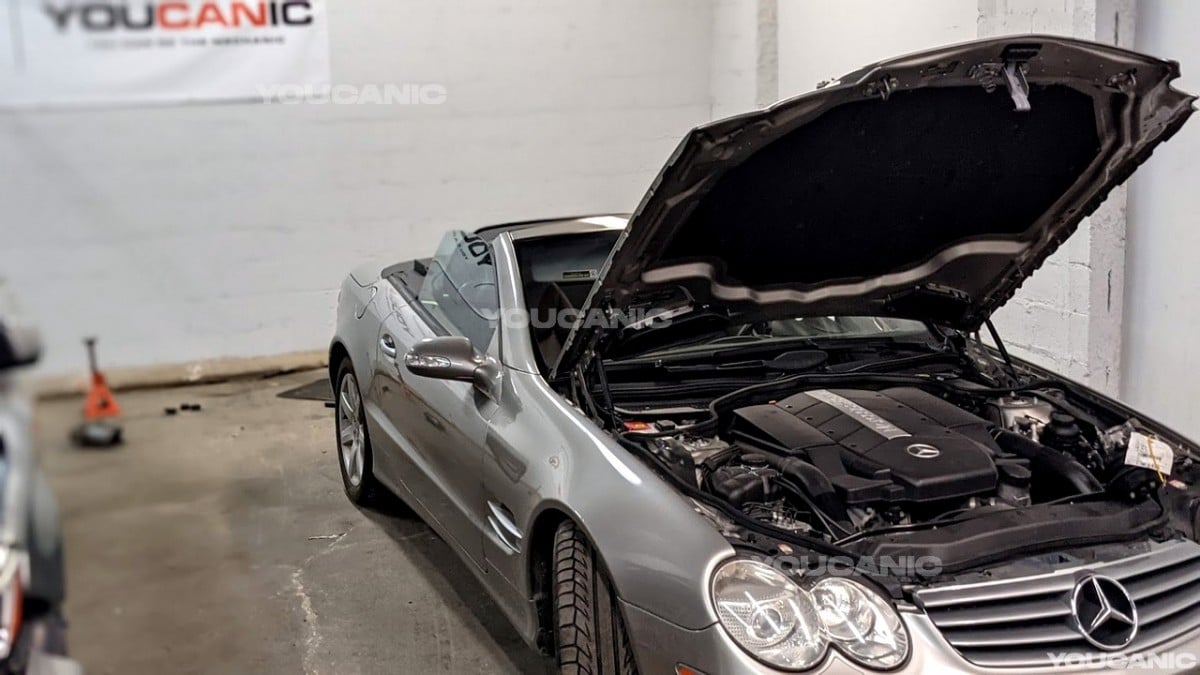
It is not uncommon for one of the corners to lower or sag when the vehicle is parked for a long time. This is normal if the vehicle is parked for weeks but not if the vehicle is parked for only a couple of days. The vehicle should rise to an average level after the engine is started.
A common problem that causes a Mercedes-Benz with ABC suspension to drop when parked includes:
- The valve block is not holding pressure. The valve block O-rings can wear over time, leading to hydraulic fluid flowing out of the strut. It is possible to rebuild the valve block or install a new or used unit.
- Struts may have a slow leak.
- A dirty filter in the ABC reservoir
“Drive Carefully” or “Visit Workshop” appears when I start the car and stay on.
A problem must be addressed if one of these warning messages disappears. Stopping and starting the car sometimes resets ABC warning messages. This problem may be caused by a:
- ABC pump – is not generating enough pressure. In the early stages, the pump may cause enough pressure after a restart, and the message goes away only to come back after driving for a time.
- Fluid leak – ABC fluid leaks are usually easy to spot, and one of the most common issues is why the ABC warning comes up or you are losing fluid. The ABC hoses can rust with time, causing a leak, but leaks can develop anywhere.
- Air in the system – can also trigger the ABC warning message. This can usually be fixed by pressuring the system and doing a RODEO test.
- Level sensor – A travel sensor or ride height sensor may be faulty.
The ABC pump may require priming to operate normally. This is done by pressurizing the reservoir using a Mercedes-Benz scanner to the hydraulic fluid circling again. Remove the splash shields under the vehicle and inspect the underside for any signs of hydraulic fluid leak.
If the problem is not leak-related, you must read the diagnostic trouble codes (DTC) from the ABC Control Unit to determine the issue. If the pump is faulty, you will get a code indicating that the ABC pump can not generate enough pressure or pressure, maybe 0 if the pump is defective or there is a large leak.
Test the ABC pump using a Mercedes-Benz scanner and monitor pressure while performing a RODEO test. During the RODEO test, the pressure should stay above 100 PSI. If the pressure drops below 100, the pump may be too weak and needs replacement.
Whine noise from ABC suspension at 2000 RPM.
Another common problem with the ABC system on Mercedes-Benz is a humming noise or winning at RPMS below 2000. A worn-out pulsation dampener can cause this noise. On the SL-Class, the pulsation damper is located behind the front-left wheel well, while on other models, such as the S/CL Class, it is attached to the undercarriage by the transmission. On models 2007 and newer, the pulsation dampener is part of the ABC pump.
Using a stethoscope to listen carefully to the various ABC components to find the noise source. Similar noise is also caused by a failed torque converter on models equipped with the 722.6 transmissions. If that is the case, you will experience a problem, and the noise is noticeable in Drive or Reverse. The noise is present regardless of the transmission gear when the problem is due to the ABC pulsation damper.
Hissing or whistling noise coming from the valve blocks
Whistling and hissing noises can come from the valve block if the air is trapped n the hydraulic lines. Depending on the model, the valve block is located in various locations, but most commonly, you will find one at the front left corner behind the bumper or the rear wheel well.
Bearing air out of the system requires running the Rodeo Test by going to Control Units > ABC Control Unit > Activations > Rodeo Test.
ABC Suspension Components
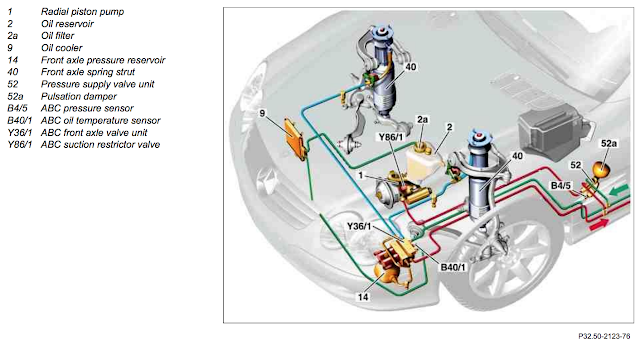
Typical components of the ABC suspension.
- ABC Control Module – The computer monitors and controls the active body suspension.
- ABC Pump – Supplies hydraulic pressure for the system
- Pulsation Dampener – Smooths out the pressure from the pump
- Pressure Limiting Valve – Bleeds off any pressure over 200 bars
- Pressure Sensor – Reports the system pressure to the control module
- Front Axle Valve Block – Controls letting fluid in and out of the front struts based on commands from the control module
- Rear Axle Valve Block – Controls allowing fluid in and out of the rear struts based on commands from the control module
- Struts – ABC struts control the vehicle height as hydraulic fluid is pumped into or out of the strut.
- Return Accumulator – Evens out the pressure on the return side of the hydraulic system (once the fluid leaves the struts)
- Return Pressure Check Valve – Maintains a minimum return side pressure of 10 bars and reports the oil temperature to the control module.
- Oil cooler – A small radiator that cools the hydraulic fluid
- Reservoir – Stores extra fluid to raise the ride height, pressurize the accumulators, and replace any leaked fluid.
- Strut position sensors – Reports the position of each strut to the control module.
- Ride height sensors – Reports to the control module how high each corner is
- Motion sensors -Reports to the control module what the car is doing motion-wise (accelerating, slowing down, cornering)
Common Problems
Based on Mercedes-Benz, we have worked on here are the most common problems with ABC suspension:
ABC Pump Failure
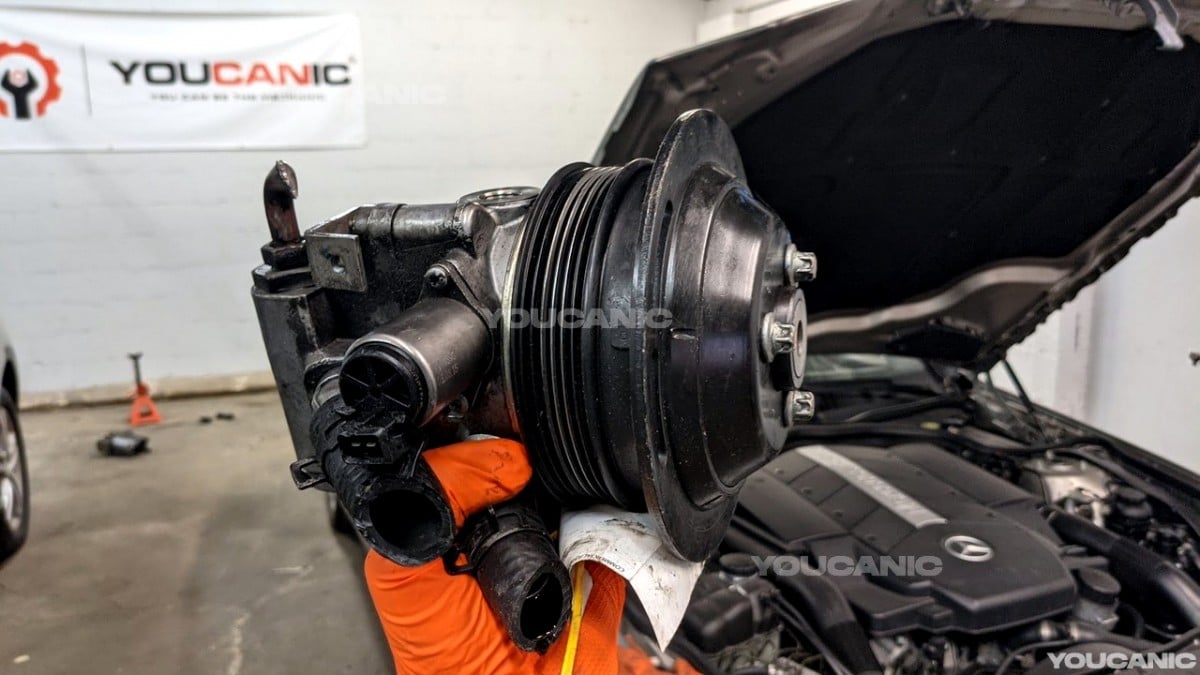
This is the TANDEM pump. It operates both the power steering and ABC suspension. Even though there is one pump for both systems, each system is separated into its own chamber.
The tandem pump has two separate chambers for each system:
- power steering
- hydraulic suspension
The hydraulic suspension chamber can fail while the power steering works fine. The pump has to be replaced as one unit, even if only one system fails.
The ABC chamber of the TANDEM pump may fail. It cannot generate pressure, so you will have under 180 bars of pressure. ABC pump rings wear and cannot have enough pressure. Keep in mind that low pressure can also be caused by:
- failed accumulators,
- valve blocks,
- leaks.
And not TANDEM pump failure. When the pump is weak, you will get pressure but intermittent ABC “Drive Carefully” and “Visit Workshop” warnings. Initially, you may get random ABC white warning messages. Eventually, the pump can not generate much pressure, which leads to more frequent error messages.
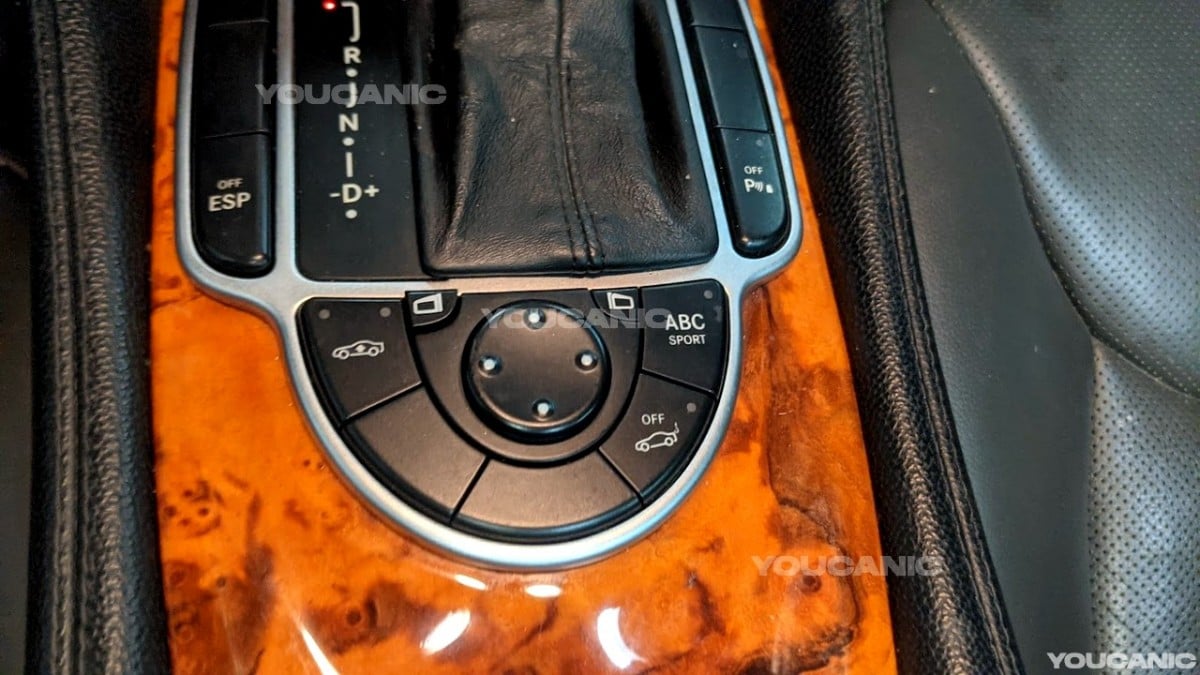
If the pump is noisy at idle but gets quiet when pressing the ride height button, this can signify a worn TANDEM pump. Performing a test for the ABC pump can confirm if the pump is weak. The ABC pump is OK if the car can get through the rodeo successfully or generate at least 180 bar pressure.
ABC high-pressure line
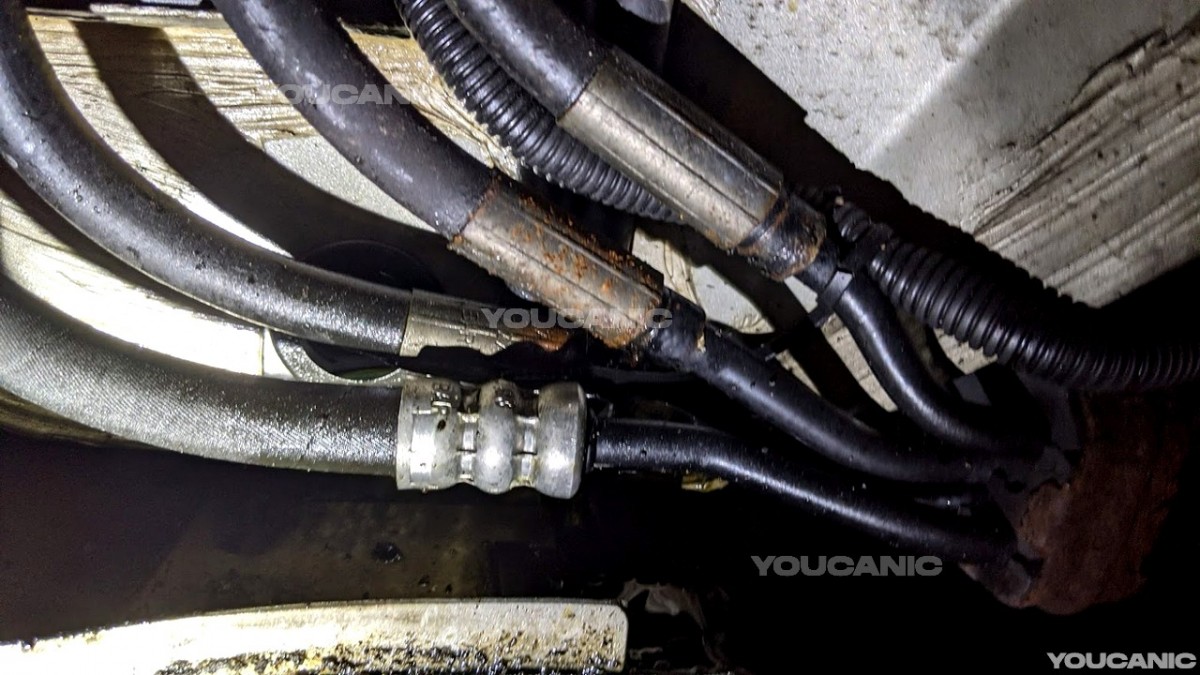
Metal and high-pressure hoses connect all the parts of the ABC system. ABC hoses can leak typically due to corrosion or an accident. A hose leak repair can cost between $200 – $650.
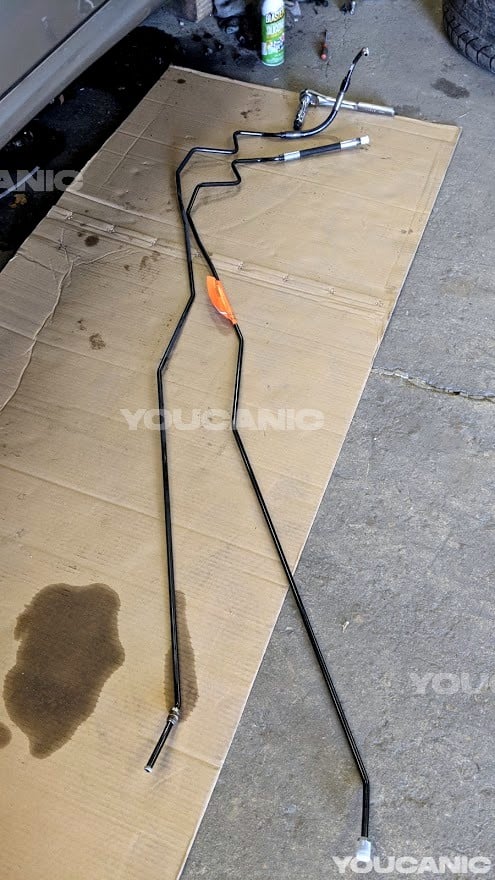
These lines are common in trucks, which means repairing the existing line by visiting a hydraulic shop that works on trucks. A repair shop can replace the bad section of the line by fitting new compression joints. This guide shows you how to disconnect an ABC quick connect.
Pulsation Dampener
The pulsation dampener is the black spherical ball. The pulsation damper serves the reservoir function and provides the required fluid as the shocks demand. This is the first component immediately after the pump. Each pulsation dampener has a membrane and an air chamber. The pulsation dampener also smoothes the pulsations and vibrations that the ABC pump causes when it pumps hydraulic fluid.
It is common for the pulsation dampener membrane to fail, which causes a loss of the dampening ability. Failed pulsation dampener in ABC suspension creates a humming or winning sound and ABC fluid pulsations in the reservoir. The ABC control module may not show a fault code if the pulsation damper is faulty.
Pulsation dampeners also have built-in release valves designed to release high pressure, for example, if it goes over 200 PSI. Pressures at pulsation dampeners are monitored via the pressure sensors (B4/5). Around 2007, Mercedes-Benz updated the ABC design by integrating the pulsation dampener into the ABC pump.
Valve Blocks
The valve blocks control hydraulic fluid that goes to each of the struts. Typically, on a Mercedes-Benz with ABC suspension, you will find two valve blocks:
– one for the front struts and one for the rear struts.
The valve block often fails due to the age of the ABC fluid. Old fluid can cause the O-rings to fail and dirt to build up inside the valve block.
If an o-ring in the valve block is worn, the car may lower at one corner. Remember that if the car lowers at one corner, the problem could be a bad strut or leak in one of the hydraulic lines.
Struts
Like standard sturts, the ABC strut contains a spring and a shock absorber. The ABC strut adds a hydraulic fluid chamber to adjust the height as fluid is added or removed from the strut. The ABC control module or driver can adjust the height at each corner of the car at a rate of 1/10 of a second.
Replacing a faulty strut at the Mercedes-Benz dealership costs between $1500 and $2000. A cheaper alternative is installing aftermarket ABC struts, which cost around $500. The cheapest solution is to install a used strut. The drawback of installing used ABC struts is that there is no guarantee on how long they will last.
Just because the car sags at one corner doesn’t mean the problem is the strut. In many cases, the issue can be the valve block. Inspect the strut for leaks. The strut may typically operate if no leaks are present, and the problem can be at the valve block.
Replacing a bad strut is pretty straightforward. There is a connection and a sensor connection; the rest of the steps to remove an ABC sturt are the same as in other struts.
After replacing a bad strut, you will need to fill the strut with fluid and then bleed the air out of the system. An advanced Mercedes-Benz scanner is required to recalibrate the ride height. Wheel alignment is recommended after replacing a strut.
Reservoir
Stores hydraulic fluid that the TANDEM pump can use on demand.
The dipstick has two marks.
- The lower marks are used when the engine is running
- The higher one is for when the system is shut off.
Leaks can develop at the reservoir itself. Check the hoses that go to the reservoir and inspect for leaks.
If the system keeps losing fluid, it indicates a leak. The leak can be due to a rusted line or a blown accumulator.
ABC Fluid
ABC fluid that has never been flushed can cause microscopic debris to wear o-rings, seals, hoses, accumulator membranes, struts, and rubber components.
Old ABC fluid shortens the life of the ABC components in the system, such as the valve block. Microscopic metal shavings can accumulate in the fluid, acting as corrosive material which damages the pump bearings and valve block o-rings.
Keep contaminants and dirt out of the fluid when checking the ABC level. Wipe the area around the dipstick clean. Contaminants entering the reservoir will enter the ABC system before encountering the filter.
Control Module
The control module controls the ABC suspension’s operation and monitors all the sensors. It contains the amount of fluid that should go to each strut based on current vehicle height and road conditions.
It controls the sport and comfort mode by making the suggestion more aggressive. It also controls vehicle height and raises the vehicle when the switch to raise the vehicle is pressed.
If it detects a malfunction with one of the sensors or the hydraulic pressure is too low, it triggers the ABC warning message by sending a signal to the Instrument Cluster (IC). In addition, a fault code gets stored in the ABC control module for further troubleshooting.
Accumulator (Nitrogen ball)
The accumulator is located near the struts and stores pressure for immediate use. The function of the accumulator is to have pressure ready for instant use when the hydraulic fluid required is beyond what the ABC pump can provide.
In other words, accumulators store pressurized hydraulic fluid so that when the valve blocks need fluid to feed to a strut, there’s a ready supply next to the valve block.
When you hit a speed bump, and ABC fluid is required, but the pump can’t provide it fast enough, the required fluid is drawn from the accumulator.
If the accumulator has a failed diaphragm and loses its gas pressure, there is very little reserve fluid in the accumulator, and when a valve tries to draw fluid, the pressure will drop.
When the ABC has a fault and goes into limp mode, the car bounces because the ABC locks all the valve blocks to seal fluid into the four struts.
How much does replacing the TANDEM ABC pump on a Mercedes-Benz cost?
A replacement pump costs between $1200 and $1500 at the dealership. At independent repair shops, replacement costs can range from $800-$1200. The DIY cost to replace the ABC pump is between $450 and $600. It is possible to purchase rebuilt ABC pumps. ABC rebuilt kits are also available if you repair your ABC pump.
If you are unfamiliar with ABC suspension on a Mercedes-Benz, don’t rush to conclude that the TANDEM pump is bad because you have low pressure. Several owners have reported replacing the TANDEM pump (an expensive repair), but the ABC light was still on, and the vehicle didn’t rise.
How to Check ABC Fluid Level
Check the ABC fluid level and make sure the level is not empty or low.
- Park on level ground.
- Turn off the engine and wait for ten minutes.
- Pull the hood release and open the hood.
- Locate the ABC reservoir on the driver’s side of the engine.
- Remove the dipstick, clean it, and reinsert it to measure the current ABC fluid level. The ABC reservoir dipstick has two marks. The upper mark is when the engine is off—the lower mark is when the engine is running. Wait ten minutes for the system to depressurize and the fluid to return to the reservoir.
- If the level is low, add Pentosin CHF 11S High-Performance Synthetic Hydraulic Fluid. Do not start the car without correcting the fluid level. This is the recommended fluid for ABC suspension, as per the Mercedes-Benz owner’s manual. It can be purchased from the dealer online. When purchased from the dealer, the container is blue but online. It is green. It’s still the same fluid.
- Start the engine and monitor the dashboard to clear the ABC dashboard warning.
Conclusion

In conclusion, troubleshooting the Mercedes-Benz Active Body Control (ABC) suspension system requires professional-grade diagnostic equipment to access and read fault codes stored in the system’s control unit. This advanced suspension technology uses hydraulic pressure to adjust the suspension in real time, allowing for precise control of the vehicle’s body roll, pitch, and dive. The ABC system is controlled by a central electronic module that receives input from various sensors located on the vehicle, and it is typically found on high-end Mercedes-Benz models. Suppose you suspect an issue with your vehicle’s ABC suspension system. In that case, it is recommended to consult with a knowledgeable dealer or mechanic who has experience with this technology to properly diagnose and repair any issues.
Do not drive or start a Mercedes-Benz with low ABC fluid. Driving with low or no fluid can destroy the ABC pump, which can be a very experienced repair. Use a power steering fluid when Pentosin CHF 11S is unavailable in an emergency. Once you reach your destination, we recommend flushing the system with the correct fluid type. Do not drive the car if the ABC fluid level is low. If it runs dry, the ABC pump can get damaged and send metal shavings into the ABC components. This will create a more experienced problem for years to come.
Frequently Asked Questions
What’s the difference between ABC vs. AirMatic suspension?
The main difference between the ABC and Airmatic suspension is that the ABC suspension uses hydraulic fluid to operate and fill the struts, while the Airmatic uses compressed air.
Mercedes-Benz ABC suspension is more complicated than the AirMatic (air suspension). ABC suspension while it provides superior handling compared to airmatic suspension. ABC suspension predisposes to develop hose leaks, worn o-rings in the valve block, and pumps that wear out.
ABC suspension is most common on high-end Mercedes-Benz vehicles such as SL500, SL55 AMG, S550, S600, CLS55 AMG, S65 AMG, and S63 AMG.
Do Mercedes-Benz cars with ABC suspension require maintenance in the winter?
Drive the vehicle at least once a month. Inactivity is hard on hydraulic systems, even more so than daily use.
What color is ABC fluid on a Mercedes-Benz?
The new ABC fluid has a green tint. Old ABC fluid is brown or black, so it is time to flush it.
Why does my Mercedes with ABC suspension lower when parked overnight?
It is common for a Mercedes-Benz with an ABC suspension to lower when parked for several weeks. Those cases are acceptable; even a Mercedes-Benz would not perform any repairs. A problem must be addressed if the vehicle lowers overnight or is parked for only a few days.
Do you need to flush Mercedes-Benz ABC fluid regularly?
Mercedes-Benz dealerships and the owner’s manual state that you do not need to flush the ABC fluid regularly, but considering the problems caused by old ABC fluid, it is better to flush the system at least every 50,000 miles. Old ABC fluid can cause the valve block seals to degrade over time, leading to car sagging when parked. The life of the ABC pump can be shortened by old hydraulic fluid.
ABC reservoir overflows after a drive.
There are two possible issues:
The reservoir is overfilled by accident. Do not fill to the top marking while the engine is running.
You may have a faulty accumulator. One of the membranes inside at least one of the accumulators may be blown. Fluid replaces the air in the accumulator. The reservoir overflowing fluid from the dipstick cap indicates that an accumulator has failed. If there is a need to keep ABC fluid levels below normal to keep the reservoir from overflowing, it means the accumulator has failed. Eventually, you will notice a drop in the ABC fluid level at the reservoir as fluid fills all the accumulators.
Suspension Fault Codes
- The B4/5 pressure sensor shows 192 bar at idle.
- Rodeo test, pressure is usually around 115-150 bar.
- C1525-001 Critical vehicle level front left
- C1525-002 Critical vehicle level front right
- C1525-032 Calibration of the plunger travel sensors has not been successfully performed
- C1525-064 System pressure too low
- C1526-016 Malfunction in pressure supply
- C1526-064 Load adjustment not successfully performed
Applications
The ABC suspension can be found in many Mercedes-Benz models, including:
- 2003-2012 R230 SL Class
- SL320, SL600, SL65 AMG, SL500, SL550, SL55 AMG,
- 2012-2021 R231 SL Class
- SL350, SL65 AMG, SL400, SL550, SL63 AMG
- 2000-2006 C215 CL-Class
- CL500, CL63 AMG, CL65 AMG, CL600, CL55 AMG
- 2006-2012 C216 CL-Class
- CL500, CL65 AMG, CL600, CL55 AMG, CL63 AMG
- 1998-2006 W220 S Class
- S280, S600, S55 AMG, S65 AMG, S320, S350, S430, S500
- 2005-2013 W221 S Class
- S280, S300, S550, S600, S63 AMG, S65 AMG, S350, S400, S450, S500
Remember that ABC suspension was an available upgrade and does not mean it is found on all the models. Most of these models had AirMatic suspension as standard, with the ABC suspension available on higher-level trims and AMG versions.
We hope you find the Troubleshooting Mercedes-Benz ABC Suspension Problems guide helpful. Check these troubleshooting and repair guides for more help on your Mercedes-Benz.








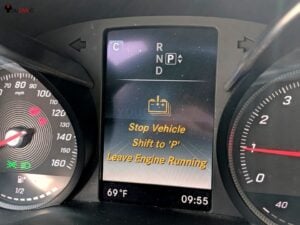
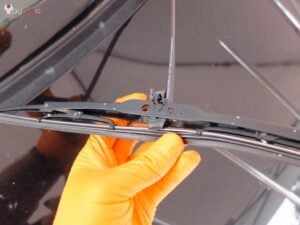

I replaced the main line hose (pump to valve body) on 2007 sl 55 amg after paying mechanic to do so he gave me a deffective hose that had a built in leak he did the rodeo all checked out then now big puddle in the garage so i replaced the hose myself furiuose of course after paying to get it done did not perform rodeo made car go up and down 20 times drove car 2 hours slow no problem next day pulling into gas station my front driver side strut stuck all the way up wont come down
disconected battery and raised car so no pressure on shocks as of now what can i do to lower front strut
Great information Thanks
Hi Len,
Was Rodeo run after replacing the ABS hose? There is a chance air may be on one of the lines. If that is already done, then I would investigate more on why its not calibrating. Post the above question on youcanic.com/support for a better experince.
Hi there. Thanks for this article as it is comprehensive. I have a 2003 S55 AMG Kompressor. ABC Hydraulic pipe burst and my troubles started. (Stopped car immediately) Fixed (Replaced pipe) Replaced both front struts (One plunger sensor failed but replaced both with Refurbished ones). Have a basic reader. (Before pipe burst replace accumulators, replace damper and serviced valve blocks (O-rings)). Main symptom, car will not go back to level as before. By opening the bleeding valves I detected very low pressure at struts (Car it trying to left and bag slowly go up front will not go up, probably of weight of engine). I suspected Pressure control valve (at damper) being damaged during pipe burst. Replaced that whole unit (including damper. Now instantly car will lift but still not to an even level Pump pressure at diagnostics 182 bar. Then brought it to 2 x Mercedes dealers for calibration (My Diagnostics cannot do that). Both dealers failed. also so tried “so called” experts who also failed to complete the calibration process. My diagnostics can show plunger positions, level sensor positions, pump pressure which are all reading properly. Even had the dealer replace and match in to the car via a network link to Germany, another ABC control unit but they said it worked but not solved the problem, Now struck. Now considering the other body sensors (Acceleration Lateral and longitudinal, yaw etc.) but no where in any publication it indicates that a fault in one of those will “Block” the calibration. According to all who tried they say it goes to the steps and passes but the last part, uploading it all into the Control Unit Fails. !!!!. What I can do:
I start the car, reset all DTC’s and the car lifts to max height all around. (Dash Lift Button works) when I the drive forward or backward ever so slightly the car drops on one side sort of trying to match the car to parameters stored in the control unit, “Thinking is is now right”. When I reset DTC’s and car it at full height I simply disconnect all plunger sensors and the RED ABC comes on (Probably shutting the whole system down) and then I can drive the car at the full height but indeed feeling bouncy. I can park it in that state and it stays up weeks on end. I NOW I AM STUCK